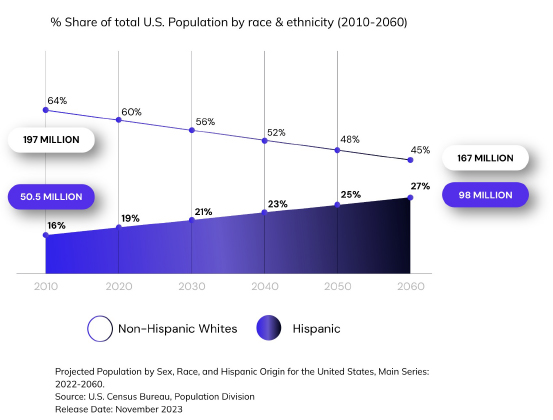2020s: The Decade of US Soccer
February 10, 2024

By Arthur Forcione, Amrak Solutions Strategic Planner
The 2026 FIFA World Cup is fast approaching and it will be the second time hosting for the USA after first hosting in 1994. And to this day it is still the most successful iteration of the World Cup, with record attendance (3.6M) and World Cup Final viewership (1.5B) – despite having only 52 games.
The 2026 World Cup will be the first edition with 80 games. 28 more than when the US last hosted. FIFA projects this World Cup to be the most successful sporting event in history with over 5M people in attendance. Given this fact, we wanted to size the popularity of soccer in America by then. To achieve this we developed a linear regression model (pictured below). And it predicted that, by 2026, 12.5% of Americans will say soccer is their favorite sport. Around 42 Million people!

So how did we get there? Well, since 1937 Gallup has been keeping a running poll asking Americans what their favorite sport is. But the problem is, they haven’t updated the poll since 2017. (Pictured here).

So in order to size the soccer opportunity, we needed to use Gallup’s historical data to project out the soccer data line through 2026. As you can see in the chart, by 2017, soccer is the only top 4 sport that is growing. So just how far can it go?
In order to predict how many Americans will select Soccer as their favorite sport in 2026, we built a Linear Regression Model. If you don’t know, linear regression models are a common tool used by economists to predict an independent variable as a function of its dependent variables. Here the independent variable is: “the percentage of Americans who say Soccer is their favorite sport”. And that data is provided by the Gallup poll above from 1937 to 2017.
The dependent variables are what make or break the model. But basically, we need to make assumptions about what are the most important factors that determine the popularity of soccer in America, and test them for statistical significance.
One of the primary drivers of Soccer’s popularity in America is the increasing Hispanic population, especially as a share of the total US population. As you can see in the chart below, by 2026, Hispanics should account for 20% of the US population– about 67M people.

But how do we know Hispanic population growth is driving the popularity of Soccer in the US? Well, if we look at the Gallup chart again we notice that Soccer hovers around 1-2% up until the late 90’s. But then, from 1998 to 2017, the popularity of people saying Soccer is their favorite sport explodes from 2% to 7%. Essentially tripling in size.

So what happened in the nineties that caused Soccer to more than triple in popularity? Well, the Hispanic population also tripled between 1990 and 2020 going from around 20 million to nearly 60 million.
And, guess what, it turns out that Hispanics love soccer! As of 2023, Hispanics are 60% more likely to be soccer fans than the average American, according to GWI USA. In fact Hispanics make up over 27% of all soccer fans – consistent with a Morning Consult poll from 2022.
And, yes, all this growth is after the 1994 World Cup, which certainly helped, but if you look near the year 1994 on the graph, the popularity of Soccer dips back to 1% after the World Cup. So if the World Cup in 1994 did have an impact on the popularity of US soccer, it wasn’t immediate. How then did the World Cup impact soccer in America?
Well, one of the conditions for FIFA to award the 1994 World Cup to the United States was that they develop a stable professional league, which didn’t exist at that point. In 1996, the MLS held its inaugural season with only 10 teams. Today the MLS has 29 teams with plans to expand to 30 in 2025.
So how is the MLS a driving factor in the popularity of Soccer in the US? Well, if you look at the Gallup graph again you see that the popularity of Soccer really starts to accelerate in 2006. But what happened in 2006? Well, in 2006, the MLS signed with ESPN its first TV broadcasting rights contract that actually paid them money. It was only $8 million dollars a year, but for the first time it was something. And it allowed the league to expand into new markets, and attract better players – David Beckham joins LA Galaxy in 2007.
From 2023 through 2033, Apple will be paying the MLS $250 million dollars a season for global streaming rights– Messi joins Inter Miami in 2023. And that is the final statistically dependent variable of our linear regression model: MLS TV Money.
So really when you look to predict the 2026 popularity of soccer, it’s not that complicated. You look at the changing demographics of the country which is becoming more and more Hispanic by the year. You look at the growth and increased competitiveness of the MLS as a top pro league in the country. And what you see is that soccer is the sport of the future. For, if 2017 Baseball and Basketball support levels hold in 2026, Soccer will become America’s 2nd favorite sport.
About Author:
Arthur Forcione is a Strategic Planner at Amrak Solutions, which helps brands connect with communities through their passions, including soccer. www.amraksolutions.com





























